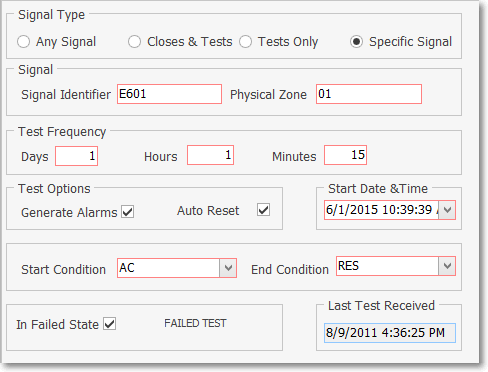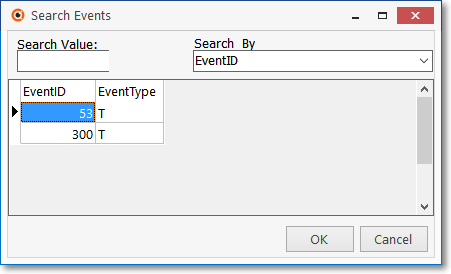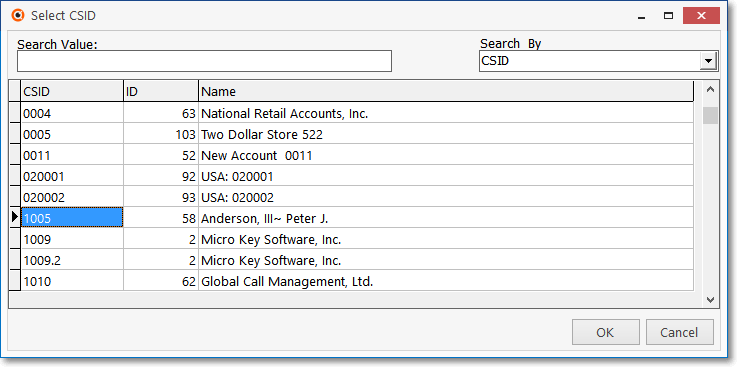❑Account Testing Overview :
•It is important for your peace of mind, and the well being of your Company's Subscribers, that monitored Alarm Systems are able to communicate properly with the Central Station.
•When was the last time that any signal was received from their system's communicator?
✓The Panels With No Signals Since... report will provide the answer.
✓No special programming or data entry is required to use this report.
•When was the last time your Subscribers actually tested - based on specifically defined criteria - their system's components and/or communicator?
✓The Failed to Test Report will provide the answer for those systems which are not specifically Supervised in some manner.
✓To effectively use the Failed to Test Report, specific Account Testing information should be defined for each Subscriber Panel CSID that your Company has installed, in order to establish what constitutes a valid Test Signal for each Subscriber's CSID.
❖Tests are only forwarded to the Master CSID Account when the CSID Event Forwarding box is Checked on this Central Station Data section, and the "UseCEF" option is set to True ("T") in Company Settings Grid.
•To establish the Account Testing requirements for the selected Subscriber Panel CSID - thereby establishing what constitutes a valid Test Signal for this Account - Open the Subscribers Form.
✓Retrieve (F2 Search) the appropriate Subscriber record.
✓Select the Edit View Icon.
✓Choose the Monitoring Tab and locate the Subscriber Panels section.
✓Select the appropriate CSID.
✓Click the Account Testing tab.

Subscriber Panels section - Account Testing tab
•Navigation Menu - The Navigation Menu is located at the top of the Account Testing Form.
![]()
✓This Navigation Menu provides the normal Record Movement, New, Delete, Save, Cancel, Refresh and Search options; as well as special Copy To and List functions.
•Record Editing section - The details of the currently selected record are displayed below the Navigation Menu at the center (Main Body) of the Account Testing Form.

Account Testing tab - Record Editing section
❑Entering the Account Testing information:
•Click the ![]() Icon to start the Account Testing entry in the Record Editing section.
Icon to start the Account Testing entry in the Record Editing section.
✓Signal Type - Select the Radio Button that best describes what will be considered a valid Test Signal for the selected Subscriber Panel.

Account Testing tab - Signal Type options
▪Any Signal - If any signal received at the Central Station constitutes a valid Test Signal for basic Account Testing supervision purposes, Click the Any Signal button.
▪Closes & Tests - If any Close, and/or any defined Test signal received at the Central Station constitutes a valid test for Account Testing supervision purposes, Click the Closes & Tests button.
▪Tests Only - If any defined Test signal received at the Central Station constitutes a valid test for Account Testing supervision purposes, Click the Test Only button. This is the default choice.
▪Specific Signal - If only one specifically defined Test signal received at the Central Station constitutes a valid test for Account Testing supervision purposes, Click the Specific Signal button.
✓Signal - If a Specific Signal is required to validate a Test, these fields will also be displayed:

Account Testing tab - Specific Signal selected as Signal Type
▪Signal Identifier - Enter the specific Signal Identifier for this Test Signal.
▪Physical Zone - Enter the specific Physical Zone, if one is required.
•Test Frequency - Enter how frequently - the maximum time since the last Test Signal - that the next valid Test Signal should be received.

Account Testing tab - Test Frequency section
➢Note: The following comments should be considered when defining the Test Frequency of the Account Testing entry for a Subscriber Panel CSID:
a)The Hours and Minutes that are entered, will be added to the Days entered, to establish the total time allowed before the next Test Signal should be received.
b)This Days plus Hours and/or Minutes method may be used to compensate for the normal "drift" of a Control Panel's timer.
c)Any other slightly inconsistent, but required Test Signal which also needs to have a follow up Test Signal sent, may also use this method.
d)Multiple Test Signal requirements may be supervised for each Subscriber Panel CSID, by simply adding additional Account Testing records.
e)Any number of Account Testing records may be defined for each Subscriber Panel CSID.
✓Days - Enter the maximum number of days allowed between Test Signals.
▪1 is the default, 0 is the minimum, 999 is the maximum.
✓Hours - Enter the number of hours (if required) allowed between Test Signals.
▪0 is the default, 23 is the maximum.
✓Minutes - Enter the number of minutes (if required) allowed between Test Signals.
▪0 is the default, 59 is the maximum.
•Test Options - Define the rules for notifying Operators about a specific Account that has Failed To Test.

Account Testing tab - Test Options section
✓Generate Alarms - Check this box to create an actual Alarm Event (Active Signal) that must be processed by an Operator.
▪At a minimum, to implement this feature, a record with a Condition Code of Failed To Test, and with a Signal Identifier of FT*, must be defined in Panel Zones.
✓Auto Reset - If you want the Test Frequency timer to reset the Start Date & Time entry if a Failed To Test Alarm Event is generated, Check this box.
▪If you do not Check this box, once a Failed To Test alarm event is generated, it will not do so again until a Valid Test - based on the definition of a valid test that was entered above - is received, at which time the Test Frequency timer is reset and supervision for a Valid Test - based on the definition of a valid test that was entered above - is re-started.
oIf an Account Testing entry for a Subscriber does not Auto Reset, once that premises has a Failed To Test occurrence, the Failed To Test Report is the only place where that information is provided.
▪If you do Check this box, if a Failed To Test Alarm Event is generated, the Test Frequency timer is reset.
oOnce the normal interval between tests expires, unless a Valid Test is received, the system will generate another Failed To Test Alarm Event.
oThis sequence will continue until a Valid Test - based on the definition of a valid test that was entered above - is received.
oThe purpose of this choice is to prevent a Failed To Test Alarm Event from being "missed" (not properly followed up) by the Central Station or the Subscriber.
▪With these two Account Testing options and the ability to create multiple Account Testing records for each Subscribers' CSIDs, the appropriate Account Testing method for tracking the follow up of a Failed To Test situation (based on whether being listed in the Failed To Test Report versus being continuously reminded with a repetitive Alarm Event) may be selected on a CSID by CSID, and/or required Test Signal by Test Signal basis.
✓Start Date & Time - Using the Drop-Down Calendar/Date Entry field provided, enter the Date and Time to "Start the Clock" running in anticipation of the next valid Test Signal, based on the rules established above.
•Supervising Other Conditions and Events - You may also supervise a situation that entails receiving a Starting Event Condition Code (that must be defined using the CSID Zone Form) which then initiates a Test Frequency timer that anticipates receiving a specific Ending Event Condition Code (also defined in the CSID Zone Form), within a specified time frame, which then satisfies the Account Testing requirement.
✓To do so, enter the Test Frequency information as explained above, and then enter the required Condition Codes below.

▪Start Condition - Use the Drop-Down Selection List to Choose the proper Starting Condition Code which must be in a record in the CSID Zone table.
▪End Condition - Use the Drop-Down Selection List to Choose the proper Ending Condition Code which must be in a record in the CSID Zone table.
•Click the ![]() Icon below the Subscriber Panels tabs to record this Account Testing entry.
Icon below the Subscriber Panels tabs to record this Account Testing entry.
❑System Maintained Information

•In Failed State - No Check will appear in this box if the system has passed its most recently required test.
✓The current Test Status is displayed in this area: PASSED TEST
•Last Test Received - The date and time of the last valid Test Signal is displayed here.
•In Failed State - A Check will appear in this box if the system failed its most recently required test.
✓That Test Status is also displayed in this area: FAILED TEST

❑Using the Special Functions on the Navigation Menu at the top of the Account Testing Form:
•Search - To locate a specific Account Testing record, Click the Search option at the top of the Form.

Search Events dialog
✓The Search Events dialog will appear.
✓Enter the Search By method using the Drop-Down Selection List (EventID or EventType).
✓Enter the Search Value characters until the desired record is displayed.
✓Click on the record when it is displayed.
✓Click OK to select the record and Close the Search Events dialog.
•Copy - You may copy all of the Account Testing records for one Subscriber's CSID, to another Subscriber (either to a different CSID installed at the Same Subscriber's premises, or to a Subscriber's CSID being monitored for a completely different Subscriber).
✓Click the Copy option

✓It will display the Select CSID dialog.
✓Search By - Select the method you'll use for this search with the Drop-Down Selection List provided.
▪CSID - Search by the CSID.
▪ID - Search by the actual internal record number.
▪Name - Search by the Subscribers Name.
✓Search Value - Enter the appropriate characters to locate the desired Subscriber to which you want to copy the currently selected People To Call.
✓Click on the desired Subscriber's CSID record.
✓Click OK to select the record to copy to, and then return to the Account Testing Form.
✓All Account Testing records for this Subscriber Panel (CSID) will be copied to the selected Subscriber's CSID.
✓If any names are not required at the new location, go to that Subscriber, Select Monitoring and then Choose Account Testing where you will then be able to delete any unnecessary tests.
•List - To view a tabular list of the Account Testing records:

Account Testing tab - List View
✓Click the List option to display the associated Grid Data.
✓The columns of Grid Data may be rearranged, filtered, and sorted.
✓Find - Enter text to search for a specific record, then Click the Find option.

▪Click on the Enter text to search... field and enter characters that best represent the specific record that you are searching for.
▪This is an incremental search from left to right.
▪As you type, based on the data type you've chosen, the record(s) that most closely matches your entry will be highlighted.
▪Click on an Account Testing record to Choose that record.
✓Clear - To remove the text to search for entry, Click the Clear option
✓Click the List option again to return to the Record Editing section.
❖See the Grids - Print Preview - Export Data chapter for additional information about using the List option